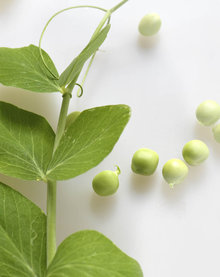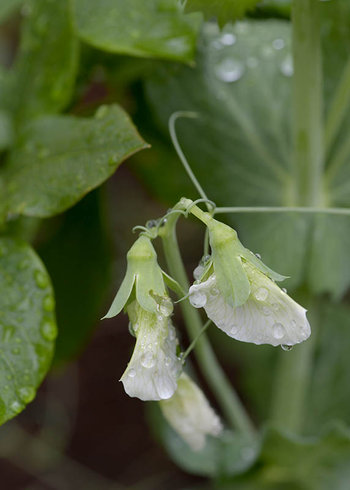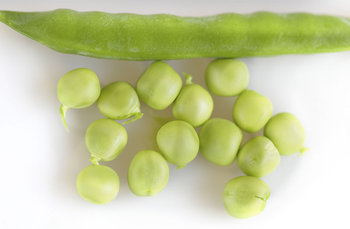Pea
|
|
| Pea | ||||||||||||||||||
|---|---|---|---|---|---|---|---|---|---|---|---|---|---|---|---|---|---|---|
 Pea pod | ||||||||||||||||||
| Scientific classification | ||||||||||||||||||
|
A pea is the small, edible round green bean which grows in a pod on the leguminous vine Pisum sativum. This legume is cooked as a vegetable in many cultures. Several other seeds of the family Fabaceae, most of them round, are also called peas; this article deals with the species Pisum sativum and its cultivars. The pea plant is an annual plant, with a lifecycle of a year.
| Contents |
History and cultivation
Peas have been found in Near Eastern archaeological sites which date back nearly 10,000 years. Domesticated cultivars appeared relatively shortly after wheat and barley, which appear to have been cultivated as long ago as 7800BC. By 2000BC, pea cultivation had spread throughout Europe and east into India and China.
Peas are a cool-season vegetable crop. The seeds may be planted as soon as the soil temperature reaches 10 °C, with the plants grow best at temperatures of 13 °C to 18 °C. They do not thrive in the summer heat of warmer temperate and lowland tropical climates, but do grow well in cooler high altitude tropical areas. Many cultivars reach maturity about 60 days after planting. Peas grow best in slightly acid, well-drained soils.
Peas have both low-growing and vining varieties. The vining varieties grow thin tendrils that coil around any available support, and can climb to be 1-2 m high. A traditional approach to supporting climbing peas is to thrust branches pruned from trees or other woody plants upright into the soil, providing a lattice for the peas to climb. Branches used in this fashion are called pea brush. Metal fences, twine, or netting supported by a frame, are used for the same purpose. In dense plantings, peas give each other some measure of mutual support.
Crop rotation is important to avoid the build-up of pests and diseases in the soil; typically peas should only be replanted on the same site every fifth year.
Types of pea
Peas grown for the immature peas are called garden peas, shell peas or green peas. They are sold fresh (usually in the pod), or tinned or frozen.
The mature pea, which dries naturally in the field, is known as the marrowfat pea. It is grown mainly in Britain, but many are exported to the Far East. One of the oldest export varieties, popular in Japan for the last hundred years, is called Maro.
Several cultivars of peas are eaten pod and all, and are known as mangetout, edible pod peas, snow peas, sugarsnap peas , sugar peas or snap peas. They are especially characteristic of oriental cuisine. The snow peas are eaten before the pod inflates, whereas the snap peas are eaten when the seeds have partly matured and the pod is round.
Field peas, also referred to as protein peas, are a cultivar of P. sativum (P. sativum 'Arvense') that are grown as forage or for hay production.
Ways of eating peas
Fresh peas are often eaten boiled and flavored with butter and/or spearmint as a side dish vegetable. Fresh peas are also used in pot pies, salads and casseroles. Pod peas (particularly sweet varieties called mangetout and sugar peas) are used in stir-fried dishes. Peapods do not keep well once picked, and if not used quickly are best preserved by drying, canning or freezing within a few hours of harvest.

Dried peas are often made into a soup or simply eaten on their own. In Japan and other Far Eastern countries, such as Thailand, Taiwan and Malaysia, the peas are roasted and salted and eaten as snacks. In the UK, marrowfat peas are used to make pease pudding (or "pease porridge"), a traditional dish. In North America, a similarly traditional dish is split pea soup.
In the United Kingdom, dried, rehydrated and mashed marrowfat peas, known by the public as mushy peas, are popular, originally in the north of England but now ubiquitously, and especially as an accompaniment to fish and chips or meat pies, particular in chippies or fish and chip shops. Sodium bicarbonate is sometimes added to soften the peas. In 2005, a poll of 2,000 people revealed the pea to be Britain's 7th favorite culinary vegetable.
Processed peas are mature peas that have been dried, soaked and then heat treated (processed) to prevent spoilage - in the same manner as pasteurizing.
Cooked peas are sometimes sold dried and coated with wasabi as an eye-watering snack.
Peas in science
Pioneering geneticist Gregor Mendel studied seven traits of pea pods in teasing out three early laws of genetics. Template:Vegetable clipart


